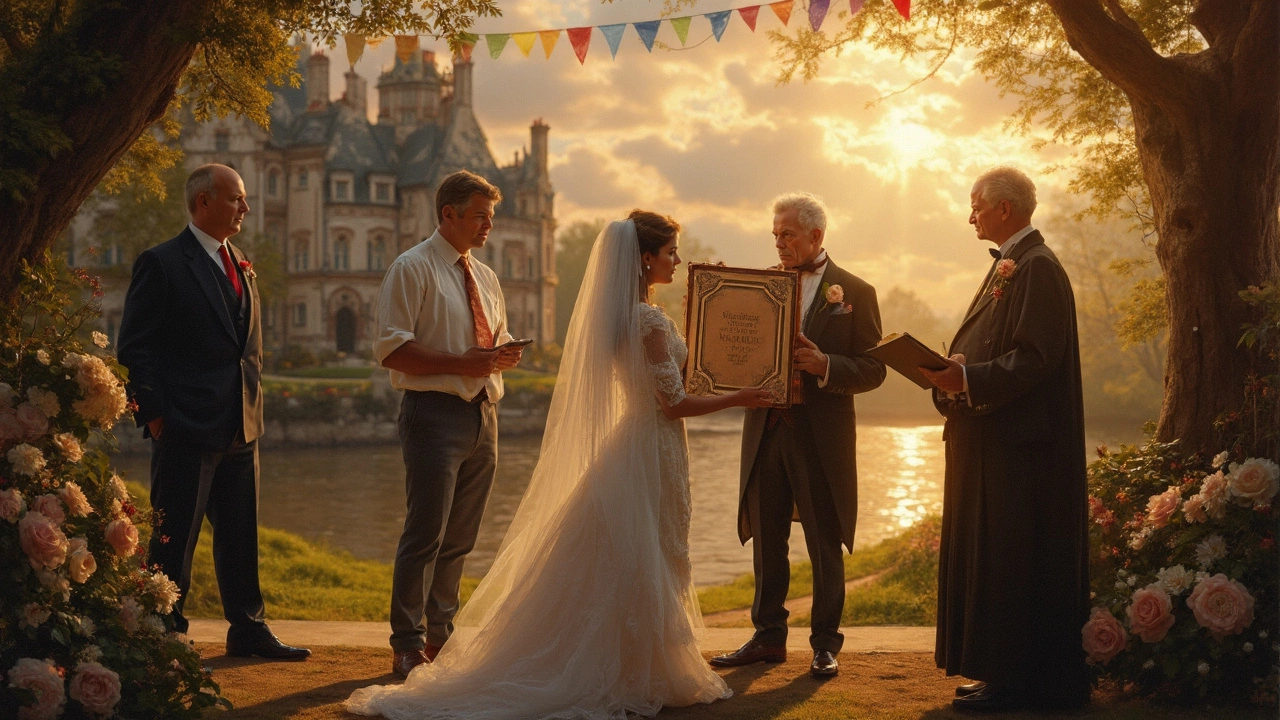Do Parents Split Wedding Costs? Here's What You Need to Know
 Apr, 6 2025
Apr, 6 2025
Weddings are a big deal and often come with a hefty price tag. So, who foots the bill? Traditionally, the bride's family paid the majority, but times are changing. Nowadays, it's more about what makes sense for each family and couple.
With more couples footing their own bills or getting creative with expenses, you might be wondering where to even start. Navigating who pays for what at a wedding is a bit like a dance, and everyone's got their own moves. It's about balancing traditions with what works for each unique situation. Start by chatting with everyone involved to figure out expectations and comfort zones.
Want to keep things peaceful and fair? Consider discussing how much each party is willing and able to contribute. being open and realistic about finances can bring everyone's vision to life while keeping things stress-free.
- Traditional Wedding Cost Splits
- Modern Approaches to Wedding Budgets
- Talking Money: How to Start the Conversation
- Common Expenses and Who Usually Pays
- Tips for a Harmonious Financial Plan
- Unique Ways to Celebrate Family Contributions
Traditional Wedding Cost Splits
Once upon a time, wedding expenses had a clear-cut template: the bride's family handled almost everything. This old-school approach included the venue, floral arrangements, and all those fancy invitations. Meanwhile, the groom's family had simpler tasks, like covering the rehearsal dinner and the oil that keeps the wheels of romance turning—the honeymoon.
Back in the day, it was all about showcasing the bride and throwing a bash to match. But hey, times have evolved. While some families still lean into tradition, others mix it up or split things more evenly, depending on what makes sense for them.
Here's a quick look at the classic breakdown:
- Bride's Family: Venue, ceremony costs, floral and decor, photographer/videographer, and all logistics of the wedding day.
- Groom's Family: Rehearsal dinner, groom's attire, and the honeymoon getaway.
- The Couple: Wedding rings and sometimes gifts for each other and their wedding party.
This structure seemed to come from an era where the bride's family 'gained' a son, so the financial load had a symbolic edge. But like all traditions, understanding the roots helps negotiate the present. Many families blend these old rules with their own practical solutions, striking a balance between keeping traditions alive and acknowledging modern realities.
Modern Approaches to Wedding Budgets
Forget those old rules where one side took on the bulk of the wedding costs. Today's weddings are all about what works best for you and your crew. It's more common for couples these days to break from tradition and opt for a blend of contributions from both families and themselves.
Think of a wedding budget like a potluck. Everyone might bring something different to the table, but the end result is a feast that's unique and balanced. Couples often team up with their parents to create a financial plan that covers all angles without stress.
Some couples choose to cover the costs themselves, especially if they're older or more financially established. On the flip side, plenty are happy to accept help from their folks if offered. The key here is communication; have an honest chat with family about what's comfortable for everyone.
What's fueling this switch-up? People are marrying later in life and might be more financially stable. Plus, weddings today can lean more personal and unique, leading to creative budgeting solutions that match the couple's vibe.
If you're piecing together a modern wedding budget, consider splitting the costs of major expenses, such as:
- Venue rental and décor
- Catering and beverages
- Photography and videography
- Attire and accessories
There's no one-size-fits-all solution. You might find that a mix of splitting costs, individual contributions, or even tackling specific expenses family by family makes the most sense.
To get it right, sit down with everyone involved and list the non-negotiables and potential splurges. Work toward a plan that feels comfortable and fair. By doing so, you’ll avoid awkward money chats at an already exciting time.
Talking Money: How to Start the Conversation
Kicking off talks about money isn't anyone's idea of fun, especially when it involves family and the whole wedding bash. But hey, it's a must-do on the wedding planning checklist. The good news? If you approach it right, it can be less awkward and more productive.
Here's a quick tip: set up a time and place specifically for this chat. You don't want to drop a bombshell while everyone's cutting into grandma's famous lasagna. Choose a relaxed setting where everyone feels comfy.
Start by laying out the vision for the wedding day. This helps focus on shared goals rather than dollar signs. Once the dream is on the table, it's easier to talk about how to get there financially.
Be honest. Families might have different ideas about who pays for wedding expenses, so it's best to express thoughts and listen openly. Create an organized list of possible costs. This way, everyone knows what they might be signing up for. Break it down like this:
- Venue Rental
- Food and Catering
- Photography and Videography
- Attire and Accessories
- Entertainment
To keep things smooth sailing, consider a mix of traditional and modern approaches. Some reports show that about 44% of couples now pay for most of their wedding expenses themselves, but family contributions can still play a vital role.
Finally, be ready to compromise. Everyone might have unique ideas about who pays for what at a wedding. The key is to make sure all voices are heard and respected, paving the way for a harmonious celebration without money throwing a wrench in the plans.

Common Expenses and Who Usually Pays
We're about to tackle a biggie—who typically foots the bill for different parts of the wedding? While there's no one-size-fits-all, some traditions and evolving norms can guide us. Whether you stick to the old-school approach or mix things up, it's all about what works for you and your family.
Let's break it down. Traditionally, the bride's family covered lots of the costs. They'd handle the venue, catering, and deco—instead of just a few flowers, think total setup. Meanwhile, the groom's side often covered the rehearsal dinner and sometimes even the honeymoon.
These days, many wedding costs are divided differently. Couples might go 50/50 or chip in what they can personally afford. It's pretty common for both families and the couple to share all costs – forgetting the old split down the aisle.
- Ceremony Venue: Usually covered by the bride's family, but many couples pay themselves.
- Reception Food and Drinks: Again, traditionally the bride's side, but a 50/50 split is common today.
- Rings: Typically the couple pays for each other’s, which adds a personal touch.
- Flowers and Decorations: Once all on the bride's family, now it's often a joint venture.
- Music and Entertainment: Usually shared amongst families and the couple.
- Wedding Planner: Often hired by the bride's family but can be a shared cost or covered by the couple.
In today's wedding scene, personalization is key. So, discuss with everyone involved and decide what matches your financial comfort zone and wedding dreams. If you’re into data, check some figures here:
| Expense | Traditional Payer | Modern Approach |
|---|---|---|
| Ceremony Venue | Bride's Family | 60% Couples, 30% Shared |
| Rehearsal Dinner | Groom's Family | 50% Couple, 50% Shared |
| Photography | Bride's Family | 45% Couples, 40% Shared |
The key takeaway? Communication is gold! Talk it out, sort the budget, and you’ll find what works for you.
Tips for a Harmonious Financial Plan
Getting everyone on the same page about wedding costs can feel like herding cats, but it's totally doable with some good planning. First things first, communication is everything. You don't want any surprises popping up right before the big day. Set up a casual meeting or a video call with everyone involved, whether it's just you and your partner, or the whole family.
In this meeting, it's a good idea to lay out a realistic budget. Consider all the major expenses and who usually pays for them. From the venue and catering to the florist, having a rough idea of costs will help you understand where everyone stands.
Here’s a simple way to keep things straightforward:
- Make a Costs List: Jot down all the big-ticket items. You'll want to include venue, dress, food, music, and any other must-haves.
- Estimate Each Item: Do a little research or ask recently married friends for ballpark figures.
- Assign Contributions: Once costs are clearer, discuss who can contribute what. This doesn’t have to follow old-school traditions unless that’s what works for you.
- Keep Checking In: Touch base every month or so, just to ensure nothing’s slipped through the cracks.
Money can be a sensitive topic, but regular chats help pave the way for a stress-free planning period. Remember, flexibility is key. Maybe one family can pitch in more on the venue while the other covers the music and entertainment.
To give you an idea of how budgets can vary, here's a quick glance at average U.S. wedding costs from 2024:
| Expense | Average Cost |
|---|---|
| Venue | $15,000 |
| Catering (per person) | $75 |
| Dress | $1,800 |
| Music/Band | $4,000 |
Use these figures as a guideline to help decide where and how to allocate money. By being open, honest, and flexible, you'll create a wedding planning environment that respects everyone's contributions and keeps things positive.
Unique Ways to Celebrate Family Contributions
Making sure everyone's efforts are recognized is a beautiful way to show gratitude. Whether it's financial help or pitching in with skills and time, these contributions can be celebrated in meaningful ways.
One idea is to highlight contributions during the wedding speech. Share stories or give shoutouts that express just how much their support means. Trust me, there's nothing like hearing a personal thank you in front of loved ones.
For those gifting financial support, consider adding a special mention in the wedding program. A simple line saying, "With gratitude to our families for their generous support" can go a long way.
If family's getting hands-on—maybe baking the cake or arranging the flowers—tell everyone! A tasteful tag, like "Arrangements lovingly designed by Aunt Lisa" not only gives credit but adds a personal touch.
Creating a family contribution board is another creative idea. Think of it as a collage with pictures and notes of who's helping out and how. Display it at the reception, and guests can appreciate who's behind the scenes.
If you want to go the extra mile, give a little keepsake to each family member involved. It could be as simple as a photo mug with a wedding memory or small personalized gifts. This gesture isn't just about recognition but about leaving them with a lasting memory.
Lastly, take a moment after the hustle and bustle to personally thank every person who's chipped in. A handwritten note expressing how their help made the day extra special can leave a lasting impression. Saying thanks makes the moment stand out and shows that their help with the wedding costs was incredibly valued.